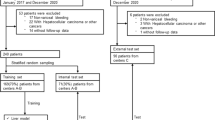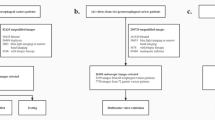Abstract
Background and aim
To develop and validate a novel machine learning-based radiomic model (RM) for diagnosing high bleeding risk esophageal varices (HREV) in patients with cirrhosis.
Methods
A total of 796 qualified participants were enrolled. In training cohort, 218 cirrhotic patients with mild esophageal varices (EV) and 240 with HREV RM were included to training and internal validation groups. Additionally, 159 and 340 cirrhotic patients with mild EV and HREV RM, respectively, were used for external validation. Interesting regions of liver, spleen, and esophagus were labeled on the portal venous-phase enhanced CT images. RM was assessed by area under the receiver operating characteristic curves (AUROC), sensitivity, specificity, calibration and decision curve analysis (DCA).
Results
The AUROCs for mild EV RM in training and internal validation were 0.943 and 0.732, sensitivity and specificity were 0.863, 0.773 and 0.763, 0.763, respectively. The AUROC, sensitivity, and specificity were 0.654, 0.773 and 0.632, respectively, in external validation. Interestingly, the AUROCs for HREV RM in training and internal validation were 0.983 and 0.834, sensitivity and specificity were 0.948, 0.916 and 0.977, 0.969, respectively. The related AUROC, sensitivity and specificity were 0.736, 0.690 and 0.762 in external validation. Calibration and DCA indicated RM had good performance. Compared with Baveno VI and its expanded criteria, HREV RM had a higher accuracy and net reclassification improvements that were as high as 49.0% and 32.8%.
Conclusion
The present study developed a novel non-invasive RM for diagnosing HREV in cirrhotic patients with high accuracy. However, this RM still needs to be validated by a large multi-center cohort.




Similar content being viewed by others
Availability of data and material
The datasets used and analyzed during the current study are available from the corresponding author.
Abbreviations
- ALB:
-
Albumin
- ALT:
-
Alanine aminotransferase
- AST:
-
Aspartate aminotransferase
- AUROC:
-
Under the receiver operating characteristic curves
- Cr:
-
Creatinine
- CT:
-
Computed tomography
- DCA:
-
Decision curve analysis
- DCE:
-
Dynamic contrast enhancement
- EV:
-
Esophageal varices
- HOG:
-
Histogram of oriented gradient
- HREV:
-
High-risk esophageal varices
- HVPG:
-
Hepatic venous pressure gradient
- INR:
-
International normalized ratio
- NRI:
-
Net reclassification improvement
- PCA:
-
Principal components analysis
- PLT:
-
Platelets counts
- PT:
-
Prothrombin time
- PTA:
-
Prothrombin time activity
- RM:
-
Radiomic model
- ROI:
-
Regions of interest
- SVM:
-
Support vector machine
- TB:
-
Total bilirubin
References
Roberts D, Best LM, Freeman SC, et al. Treatment for bleeding oesophageal varices in people with decompensated liver cirrhosis: a network meta-analysis. Cochrane Database Syst Rev. 2021. https://doi.org/10.1002/2021/013155
Jia-Li Ma, Ling-Ling He, Ping Li, et al. Clinical features and outcomes of repeated endoscopic therapy for esophagogastric variceal hemorrhage in cirrhotic patients: ten-year real-world analysis. Gastroenterol Res Pract. 2020. https://doi.org/10.1155/2020/5747563
Tripathi D, Stanley AJ, Hayes PC, et al. U.K. Guidelines on the management of variceal haemorrhage in cirrhotic patients. Gut. 2015;64:1680–1704
Garcia-Tsao G, Abraldes JG, Berzigotti A, et al. Portal hypertensive bleeding in cirrhosis: risk stratification, diagnosis, and management: 2016 practice guidance by the American Association for the study of liver diseases. Hepatology. 2017;65:310–335
Chinese Portal Study Group (CHESS). Chinese Society of Gastroenterology. Consensus on clinical application of hepatic venous pressure gradient in China. Zhonghzua Gan Zang Bing Za Zhi. 2018;26:801–812
Xie W, Chen FX, Zhu LY, et al. Risk assessment of first upper gastrointestinal bleeding using computerized tomoscanning in esophageal varices patients with cirrhosis and portal hypertension. Medicine (Baltimore). 2020;99:e18923
Han X, An W, Cao Q, et al. Noninvasive evaluation of esophageal varices in cirrhotic patients based on spleen hemodynamics: a dual-energy CT study. Eur Radiol. 2020;30:3210–3216
Inokuchi Y, Uematsu M, Takashina T. Diagnostic accuracy of the attenuation value in abdominal contrast enhanced dynamic multi-detector-row computed tomography for esophageal varices in patients with liver cirrhosis. Eur J Radiol Open. 2021;2021: 100347. https://doi.org/10.1016/2021/100347
Li Y, Li L, Weng HL, Liebe R, Ding HG. Computed tomography vs liver stiffness measurement and magnetic resonance imaging in evaluating esophageal varices in cirrhotic patients: a systematic review and meta-analysis. World J Gastroenterol. 2020;26(18):2247–2267
Ji GW, Zhu FP, Xu Q, et al. Radiomic features at contrast-enhanced CT predict recurrence in early stage hepatocellular carcinoma: a multi-institutional study. Radiology. 2020;294:568–579
Xiao-Yuan Xu, Hui-Guo D, Wen-Gang Li, et al. Chinese guidelines on the management of Liver cirrhosis(abbreviated version). World J Gastroenterol. 2020;26(45):7088–7103
Shiha G, Ibrahim A, Helmy A, et al. Asian-Pacific Association for the Study of the Liver (APASL) consensus guidelines on invasive and non-invasive assessment of hepatic fibrosis: a 2016 update. Hepatol Int. 2017;11(1):1–30
Crabb DW, Lm GY, Szabo G, et al. Diagnosis and treatment of alcohol-associated liver diseases: 2019 practice guidance from the American Association for the Study of Liver Diseases. Hepatology. 2020;71(1):306–333
Mack CL, Adams D, Assis DN, et al. Diagnosis and management of autoimmune hepatitis in adults and children: 2019 practice guidance and guidelines from the American Association for the Study of Liver Diseases. Hepatology. 2020;72(2):671–722
Mohammed E, Shiv SK, Wong VWS, et al. The Asian Pacific Association for the study of the liver clinical practice guidelines for the diagnosis and management of metabolic associated fatty liver disease. Hepatol Int. 2020;14(6):889–919
Chinese Society of Hepatology, Chinese Society of Gastroenterology and Endoscopy. Guidelines for the diagnosis and treatment of esophageal and gastric variceal bleeding in cirrhotic portal hypertension. Zhonghua Nei Ke Za Zhi. 2016;55:57–72
Tajiri T, Yoshida H, Obara K, et al. General rules for recording endoscopic findings of esophagogastric varices (2nd edition). Dig Endosc. 2010;22(1):1–9
De Franchis R. Expanding consensus in portal hypertension: report of the Baveno VI consensus workshop: stratifying risk and individualizing care for portal hypertension. J Hepatol. 2015;63:743–752
Kravetz D, Bildozola M, Argonz J, et al. Patients with ascites have higher variceal pressure and wall tension than patients without ascites. Am J Gastroenterol. 2000;95:1770–1775
S Augustin, M Pons, JB Maurice, et al. Expanding the Baveno VI criteria for the screening of varices in patients with compensated advanced chronic liver disease. Hepatology 2017; 66(6):1980–1988.
Ferraioli G, Wong VW, Castera L, et al. Liver Ultrasound Elastography: an update to the world federation for ultrasound in medicine and biology guidelines and recommendations. Ultrasound Med Biol. 2018;44:2419–2440
Li H, Chen TW, Li ZL, et al. Albumin and magnetic resonance imaging-liver volume to identify hepatitis B-related cirrhosis and esophageal varices. World J Gastroenterol. 2015;21:988–996
Jhang ZE, Wu KL, Chen CB, et al. Diagnostic value of spleen stiffness by magnetic resonance elastography for prediction of esophageal varices in cirrhotic patients. Abdom Radiol (NY). 2021;46(2):526–533
Son JH, Lee SS, Lee Y, et al. Assessment of liver fibrosis severity using computed tomography-based liver and spleen volumetric indices in patients with chronic liver disease. Eur Radiol. 2020;30:3486–3496
Rajkomar A, Dean J, Kohane I. Machine learning in medicine. N Engl J Med. 2019;380(14):1347–1358
Sousa M, Fernandes S, Proenca L, et al. The Baveno VI criteria for predicting esophageal varices: validation in real life practice. Rev Esp Enferm Dig. 2017;109:704–707
Funding
This study was supported by the State Key Projects Specialized on Infectious Diseases (No. 2017ZX10203202-004), Digestive Medical Coordinated Development Center of Beijing Hospitals Authority (No. XXT24 and XXZ0801) and Sino-German Cooperation Group (No. GZ1517).
Author information
Authors and Affiliations
Contributions
YY, YL and CF were contributed equally to collecting the data, development and validation RM. HD designed the project and was in charge of the manuscript. ZD and KH performed the language polishing and scientific editing. LL and HD were contributed equally to writing and editing. All authors read and approved the final manuscript.
Corresponding authors
Ethics declarations
Conflict of interest
Yijie Yan, Yue Li, Chunlei Fan, Yuening Zhang, Shibin Zhang, Zhi Wang, Tehui Huang, Zhenjia Ding, Keqin Hu, Lei Li, and Huiguo Ding declare no conflict of interest.
Ethics statements
All procedures followed were in accordance with the ethical standards of the responsible committee on human experimentation (institutional and national) and with the Helsinki Declaration of 1975, as revised in 2008.
Additional information
Publisher's Note
Springer Nature remains neutral with regard to jurisdictional claims in published maps and institutional affiliations.
Rights and permissions
About this article
Cite this article
Yan, Y., Li, Y., Fan, C. et al. A novel machine learning-based radiomic model for diagnosing high bleeding risk esophageal varices in cirrhotic patients. Hepatol Int 16, 423–432 (2022). https://doi.org/10.1007/s12072-021-10292-6
Received:
Accepted:
Published:
Issue Date:
DOI: https://doi.org/10.1007/s12072-021-10292-6




